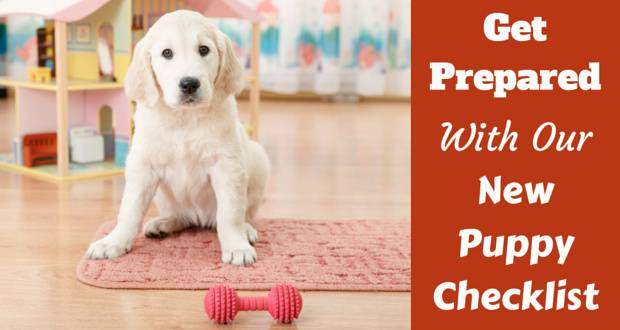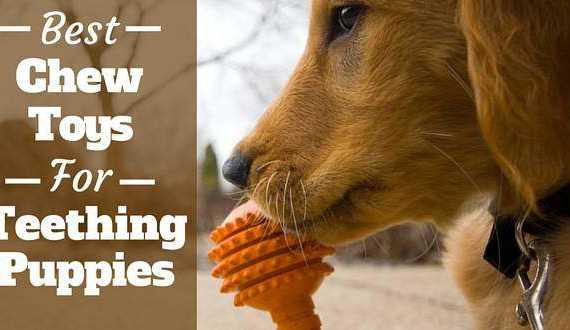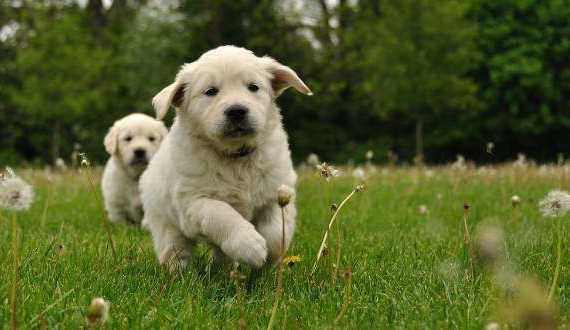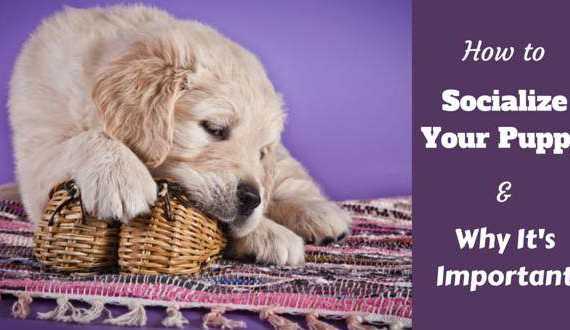Updated: August 10th, 2022

Like the decision to bring any new family member into your home, getting a puppy is a huge responsibility and shouldn’t be taken lightly.
The fact that you’re here researching what you need to do before bringing your new puppy home is encouraging, but you should also be completely certain you have the time, space, patience and energy to devote to a pup around the house.
If you’ve carefully considered all this and arrived at your decision, then great! Let’s take a look at our new puppy checklist that contains everything you’ll need to buy, do, and consider before bringing a Golden Retriever puppy into their new home.
What You’ll Need To Buy for a New Puppy
Nobody ever said that getting a puppy was cheap, and if this is your first time as a dog-parent, there might be a bit of a learning curve with all the equipment and other items that a dog needs. This comprehensive list covers all the essentials, plus some added extras.
- Food: Every dog needs food! Start your puppy on the food they’re used to eating and gradually change brands (if you want to) to avoid upsetting their stomach. See our puppy food guide for recommendations.
- Bowls: Your puppy is going to need something to eat that food from. You’ll need two bowls, one for food and one for water.
- Collar and leash: Your pup might not be able to go walkies until fully vaccinated, but you’ll want a soft collar and leash to get them used to it around the house and in the garden.
- ID tags: Even if you get your puppy microchipped, it’s always best to have ID tags, too. Plus, in some areas they’re required by law. These should have your name, address and phone number on, plus your dog’s name if you want.
- Harness: Many owners are now choosing harnesses over regular collars, which can damage a dog’s neck if they pull on the leash. Something to think about.
- Bedding: Your pup will need a comfortable bed to call their own. You can decide whether to choose a puppy-sized one or one that they can grown into.
- Crate: If you decide to crate train your dog, you’ll need an appropriately sized crate. To avoid buying more than one crate, you can get one big enough to fit your adult golden and make it puppy-sized using dividers.
- Brushes: Get your puppy some brushes suitable for a longer-coated dog. The sooner you get pup used to being brushed, the easier it will be in the future.
- Shampoo: Again, it’s good to get your puppy used to being bathed right away, so you’ll need some dog-friendly shampoo.
- Toothbrush and toothpaste: These are daily essentials in your grooming routine. Be sure to choose a dog-specific toothpaste as the human stuff can be dangerous to canines.
- Poop bags: You’re going to need a lot of these, not only from when your puppy starts going on walks, but right away, to clean up your garden and any little accidents around the house.
- Puppy pads: We’d advise trying to teach your pup to toilet outside every time, but for some people, puppy pads are a useful toilet-training aide.
- Treats: Essential for training. Pick high-value treats for when you really want to motivate your pup.
- Toys: You’ll want to get a range of toys to keep your puppy entertained. Chew toys are essential to help direct chewing away from your belongings. Tug toys, balls to play fetch and treat-dispensing toys are also nice to have. Choose appropriately-sized toys that aren’t small enough to lodge in your puppy’s throat.
- Travel harness or dog guard: To keep your dog safe in the car.
- Baby gates: If you want to make certain parts of the home off limits while you’re out, baby gates are your friend.
- Coats: Unless you live somewhere extremely cold, your golden retriever probably won’t need a coat for warmth, but a waterproof coat is handy if you live in a rainy area.
Puppy Proofing Your Home and Garden
If you want to get through the first few months without having all your favorite possession destroyed, then you’ll need to puppy proof your home before your new addition arrives.
But, puppy proofing isn’t just for the benefit of your belongings, it will also help to keep your puppy safe when you can’t be there to supervise them.
These are the main things you need to think about when puppy proofing your home.
- Move any chewable items: Things such as shoes, socks, belts, books and even phones are likely to get chewed if they’re left where a puppy can reach them. Basically, anything small enough to fit in your pup’s mouth is at risk. Don’t leave small items on the floor or on low tables. Put them up high or away in their proper place. Not only will it leave you out of pocket if your pup chews something expensive, many such items are also choking hazards.
- Be careful of plants: Make sure you remove any plants that are poisonous to dogs, both in your house and your garden. Common offenders include foxglove, wisteria and yew.
- Secure medicines and cleaning products: Both medicines and cleaning products can be highly toxic to dogs if ingested. Make sure they’re kept high up, or in cupboards with childproof latches if they must be at puppy-level.
- Hide electrical cords: If a puppy sinks their teeth into an electrical cord, it can prove fatal. Try not to have electrical cords running across the room or out in the open where your puppy can get to them. If needs be, you can get cord concealers, cord wraps or even pvc pipes to secure them.
- In the bathroom: Keep your toilet lid closed and don’t leave full sinks or tubs unattended, as these are potential drowning hazards.
- Tie up blind cords: If you have blinds with long looped cords to move them up and down, tie these up well above puppy height, as there’s a risk they could strangle your puppy if they got tangled up in them.
- Secure your garden: If you’re planning on letting your puppy explore your garden off the leash, make sure that it’s fully secured with no puppy-sized gaps in the fencing.
- Garbage bins: Make sure your garbage is kept in lidded bins that can’t be opened by an eager pup, as there are plenty of hazards in the average trash can that you don’t want your puppy to get their mouth around.
Planning Appropriate Puppy Socialization
Socialization, with both humans and other dogs (plus other animals, if your new puppy is going to be around them), is one of the most important things to think about with your new puppy.
A well-socialized puppy should turn into an adult dog who interacts well with all dogs and people, which makes your life so much easier as a dog-owner.
The first couple of days, it’s best if your puppy just meets those people, and any animals, who they are going to be sharing their home with, but after that it’s good for your pup to meet as many dogs and people as is safe and possible.
Although your dog shouldn’t be out and about, other than in your garden, until they’re fully vaccinated, some vets host puppy parties at their clinics so that younger puppies can interact with one another in a safe and clean environment. This is a great idea because, once your pup has been fully vaccinated, they will already be out of the stage in their life when they’re most receptive to new things, including meeting new dogs without being nervous or aggressive.
It’s also great for your pup to meet a variety of new people, and it won’t be hard to convince your friends to come over and hang out with your adorable new pal!
However, it is important to talk to anyone meeting your pup about any rules you have for interacting with them, as your don’t want puppy to be scared or to pick up any bad habits.
For instance, if you’re training your puppy to stop play biting or jumping up, carefully explain to anyone meeting your puppy what to do if a situation like these arises. It might sound a bit over the top, but it will stop your pup from getting confused or overstimulated and it sets some ground rules for the humans involved, too.
Deciding On A Routine
Puppies thrive on a fixed routine and you’ll usually find your canine companion settles in much quicker, and is toilet trained much quicker, if they have a schedule.
It’s important to think about this routine before you even decide to get a puppy, because you have to ensure you have enough time to meet the needs of a young dog.
For instance, if everyone in your household works or is at school full time, that’s not going to cut it for an 8-week-old puppy, as they’ll need to go outside to do their business every two to four hours.
Pick out regular meal times for your puppy and try to stick to them as closely as possible. Also take your puppy out into the garden on a schedule, as this will really help with toilet training. Although that’s not to say that your pup won’t need to go out in between scheduled times, as well!
You can also schedule in training sessions, play sessions and, when your puppy is old enough, their daily walks.
Learning How To Train Your Puppy
You might think that training your new dog will be intuitive when you get them home, but dog training is a skill you learn, not one you just pick up as you go along.
If this is your first dog or you haven’t had a puppy in the house for some time, then you’ve got some serious reading to do before you get your puppy home.
You’ll need to read plenty of articles on reputable dog-care or dog-training websites that teach positive reinforcement training methods, as these are both highly effective and totally humane.
Many people also find videos to be useful when learning training techniques, as it’s often easier to see how something’s done by watching another person doing it compared to simply reading about how to do something, which can sometimes be confusing if it’s a complex method.
Once your puppy is old enough, group puppy training classes are an excellent idea. Not only will you learn more about training your pup, your dog will also get to socialize with other young canines.
Bringing Your Puppy Home In The Car
When the big day arrives and it’s time to bring home your new puppy in the car, you’ll need to be fully prepared. It’s not okay to just sit them on the passenger seat and get going!
It first car ride can be terrifying for a puppy as it’s a totally new experience with new sounds, smells, noises and sensations.
While having a dog travel in a crate or in the back of a car, behind a dog guard, is usually totally fine, this can be overwhelming for a puppy’s first car ride.
The ideal option is to have the puppy in the back seat in a car harness and have a passenger sit next to them, who can hold, pet and comfort them on the journey home.
Some people forgo the harness altogether and have a passenger simply hold the puppy, wrapped in a blanket or towel. We wouldn’t completely condemn this idea but it has the potential to be dangerous if there was an accident on the way home.
However, before you even get your puppy into the car, you should try to get them to relieve themself first, to avoid any toilet-based accidents on the journey home. If it’s a journey of more than an hour or so, you may need to stop for additional bathroom breaks on the way.
Conclusion
There’s a lot to think about when deciding to get a puppy and preparing to bring them home. But, it’s definitely worth going over everything carefully as it’s preferable to finding yourself unprepared.
Once you get your precious pup home, all that effort and preparation will have been worth it to give your new four-legged friend the best start in life.



